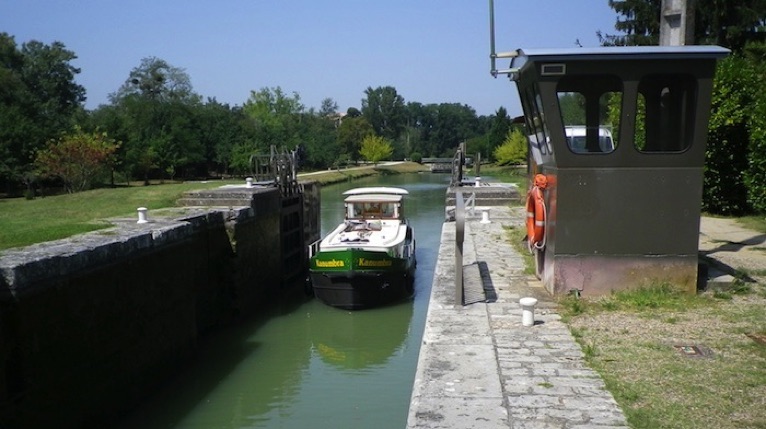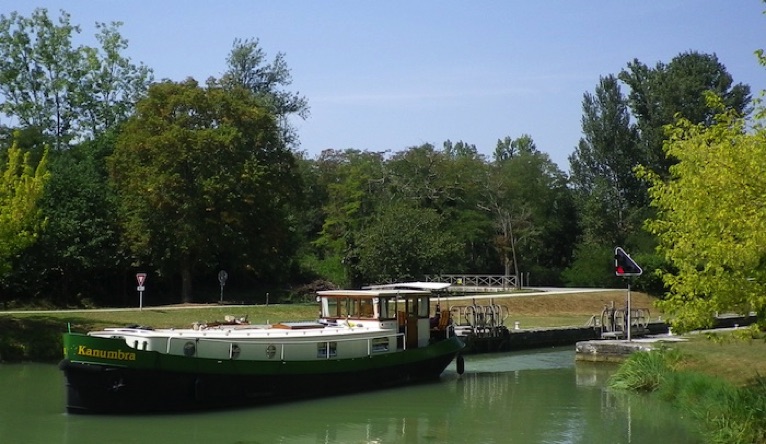
Saturday 20 August - back to canal, practice up-locks, west Agen mooring
Next morning, we decided to head back to Buzet then continue on the Garonne Canal back towards Moissac. We figured that it would be best to get more experience with uphill locks on the canal where the locks were a bit easier and more well-known to us. Maybe next year, we'll do the Baise again. For the record, after a few more uphill locks on the Garonne, this is the procedure we adopted.
For the uphill locks, I would generally pull over to the side of the canal just before getting to the twister, to let Rita off (often at a small wooden dock put there for that purpose). I would then bowthrust the bow out to the centre of the canal and slowly cruise up to the twister, which I would then engage. If there was not a landing point, or if we could see steps on the front end of the lock, then Rita would sometimes alight there, after I had slowed to a stop. Generally, I preferred the former. Rita would then walk up to the lock and confirm, by hand signals, on which side of the lock the control box was located (usually this was the same as shown by the blue dot in the Guide Fluvial, but not always). Unlike the Baise, the approaches to the locks on the canal are generally straight, giving plenty of time to line the barge up with the middle of the far gates. The only thing to watch out for was discharge from the overflow channels, which often gave a strong cross-flow just before getting to the lock. I would move in slow forward until the bow reached the lock, and then go to neutral. When the barge was half-way in, I would engage reverse to slow the barge, keeping to the side with the control box, and bringing the barge to a halt with the rear bollard on the boat just in front of the dock bollard I wished to tie to.

Once the barge was stopped, I would engage neutral (on our first locks, I often forgot to engage neutral, with the result that the barge would stop, but then start moving backwards!), then step out and throw the pre-prepared rope up to Rita who was standing by the back bollard on the dock. She would loop it round the bollard and throw it back down to me. I would loop it round the bollards, and lightly tie if off. If the bow was not already close to the dock I would bowthrust it across, then we would both walk to the front bollards. I would then throw the bow line to Rita who would loop it round the bollard and throw it back to me. I would loop it around the deck bollard and if necessary, pull the bow into the dock. While this was being done, Rita would walk to the green button and push it to start the locking procedure, then step across to the roof of the wheelhouse (in nearly every case, this was close to the level of the dock), down onto the cabin roof, then walk to the bow. I would hand her the bow line, then walk back to the wheelhouse, check again that it was in neutral, then untie the stern line and hold it looped around the bollard. In most of the Garonne Canal locks, the bollard spacing was such that the stern line went backwards to the dock bollard, while the bow line went forward to the dock bollard. In this way, Rita would take the initial push backwards with her bowline, whereas I would take the subsequent, stronger push forwards with the stern line.

Once the locking cycle had completed and the front gates had opened, I would release the stern line, return to the wheel to adjust the rudder, give Rita the sign to release the bow line, then bowthrust the bow out a little and apply forward thrust to move the barge forward, using the rudder to keep the stern centred in the lock as we departed.
After leaving the double lock out of Buzet, we crossed the aqueduct over the Baise. Even though this is a relatively short aqueduct, I still had trouble keeping in the centre, as the noise of the bowthruster in the video below demonstrates:

After stopping at Au Canal (Phillipot Park) for lunch, we continued on, hoping to get to Agen that night. We arrived at the first of the four locks before the Agen Aqueduct at about 6.55pm and twisted the twister, but had to wait until another boat came out of that lock. I manoeuvred back and forth on the bend towards the lock, trying to retain position out of the way of the departing boat, but mainly succeeded in just annoying the fishermen at that point on the canal. We waited and waited for the green light, but only got a flashing yellow. Finally, Rita came back from the lock and apologised to the fishermen, who then explained that the flashing yellow meant that they had closed the locks for the night. So we backed up a way, and tied to the bank for the night, and had a pleasant back deck dinner.
